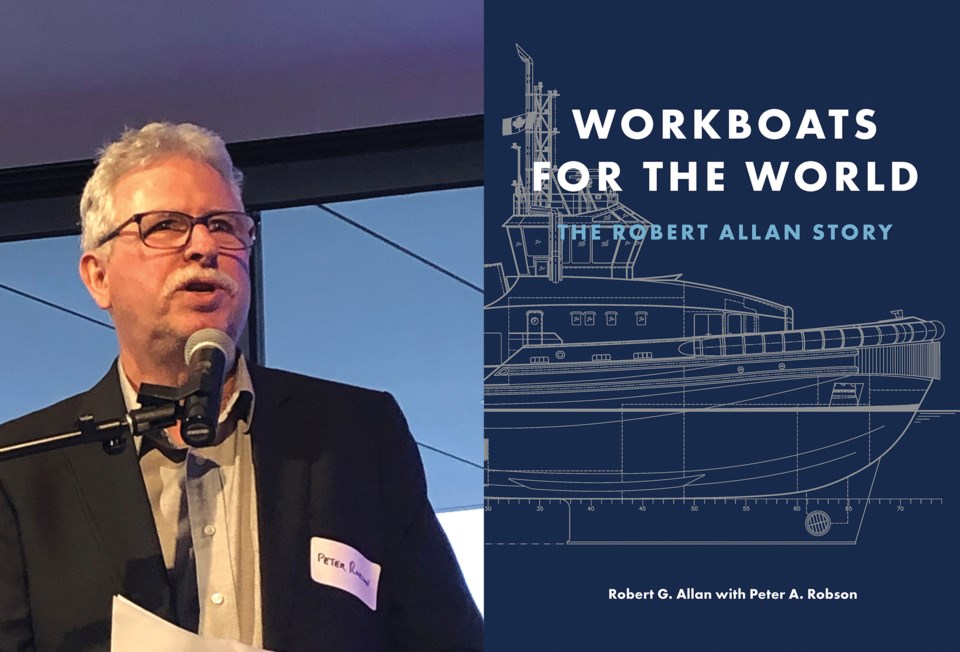The magisterial tale of a B.C. maritime dynasty, co-written and published on the Sunshine Coast, has won a prestigious award for oceanic history.
Workboats for the World: The Robert Allan Story chronicles the Vancouver naval architecture firm’s route to global influence.
“Each week, somewhere around the world, there’s a Robert Allan vessel design being finished and delivered,” said co-author Peter Robson.
Robson, who lives in Garden Bay, worked alongside Robert G. Allan to write and edit the book. Allan is the grandson of company founder Robert Allan, who emigrated from Scotland to Vancouver in 1919. The senior Allan’s first responsibility at Wallace Shipyard (later Burrard Dry Dock) was to design the CP steamship Princess Louise, which carried well-heeled travellers between Vancouver and Alaska for four decades.
Last week, the North American Society for Ocean History (NASOH) named Workboats for the World a 2023 recipient of the John Lyman Book Award. The prize recognizes excellence in the publication of books that make significant contributions to the study and understanding of maritime and naval history.
The expansive, richly illustrated volume was published by Harbour Publishing of Madeira Park and designed by Terra Firma Digital Arts in Roberts Creek.
Robson is a veteran of Harbour Publishing projects, including the 2000 Encyclopedia of British Columbia, for which he served as production manager. His literary career includes seven years as editor of Pacific Yachting magazine, and authorship of numerous books and articles on west coast industries.
“I had the writing experience and the boating experience,” Robson said, “but when I got introduced to Rob Allan at the beginning of the project, none of us knew how the story would unfold, how it would be framed and organized. We didn’t have a clue. But Rob said: ‘I want to do it right.’”
As well as corporate chronology, the book documents two family trees: the growth and influence of the Allan clan itself, and the vast fleet of vessels designed by the company over 95 years.
“The family made it all possible in the beginning,” said Robson, “because they were brilliant designers — all of them — and they were really innovative. Rob’s father [Robert F. Allan, who joined his father’s practice in 1946] was a visionary. They speak at conferences all around the world, and they’re really in demand because of what they’ve created.”
The Robert Allan firm transitioned from private practice to an incorporated company in 1962. Its early designs — fishing vessels, coastal mission boats and ferries — fuelled the expansion of British Columbia’s waterways. The book is upfront about challenges, such as the 1994 BC Ferries Corporation commission for two fast multi-hulled ferries.
“Sometimes, no matter how good our design and engineering work, projects just don’t work out,” writes Allan.
“I think it was important to include stuff like that and to set the record straight,” added Robson, “in case people were thinking that Robert Allan was the reason that the fast ferries were a problem. Several times, he also slams Transport Canada a bit for making rules that don’t make any sense.”
The company achieved global prominence with its innovations in barge and tugboat design. Booming was transformed by self-loading and self-dumping barges. Wooden log-towing and barge-towing tugs gave way to steel ship-handling tugboats. Designs for C.H. Cates & Sons resulted in highly manoeuvrable twin propeller tugs; Cates also commissioned the first harbour tug in Canada to use steerable rudder-propellers.
In 2008, the Robert Allan firm was restructured with employee ownership. Robson interviewed members of the ownership team for the book. “They absolutely love the opportunity,” he said, “and I think you get a lot more dedication from the people if they have an ownership stake in what they’re making.”
Workboats for the World was officially launched on April 5 in North Vancouver, and was named a medallist in the Axiom Business Book Awards six days later. The John Lyman Book Award was announced on May 24.




